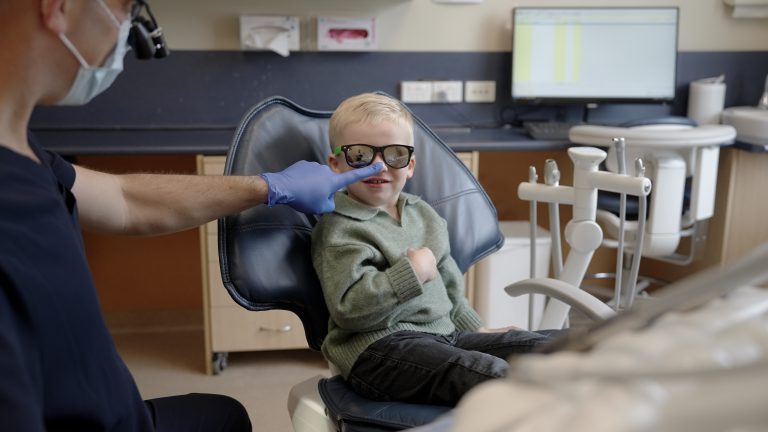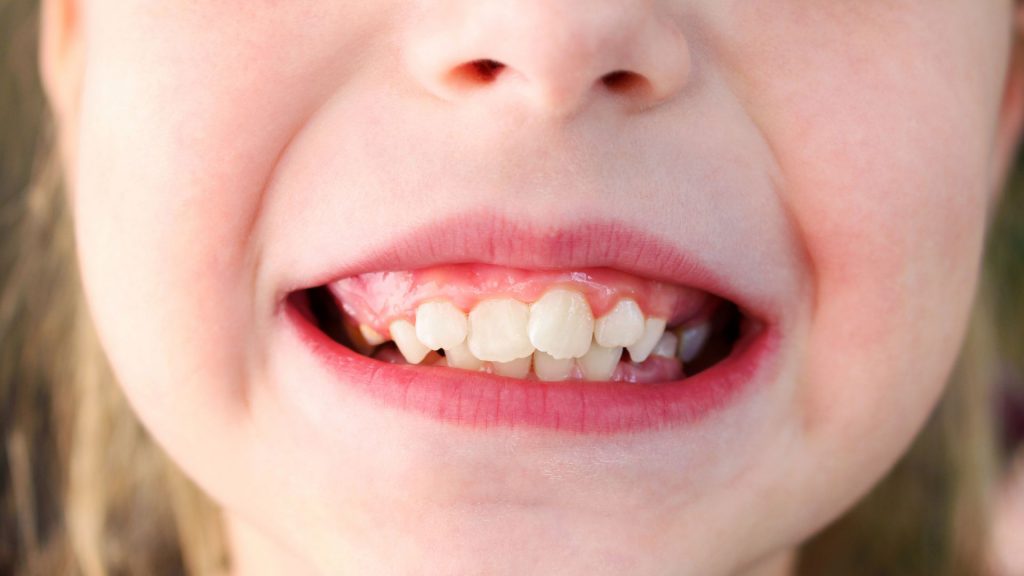Things That Can Go Wrong with Babies’ and Kids’ Teeth

Written by Dr Amanda Lin, Sydney paediatric dentist at the Children’s Hospital at Westmead and Macarthur Paediatric Dentistry
Understanding common dental conditions can help you as a parent or caregiver take simple steps to prevent or detect issues early. Here are some key concerns to know, and tips to help protect your child’s smile.
Tooth Decay
Tooth decay, known as dental caries or cavities – affects one in three Australian children before they start school,1and is the most common chronic childhood disease worldwide.2
When left untreated, it can spark pain, cause trouble eating and sleeping and mean difficulty concentrating at school.3It also increases the risk of developmental damage to permanent or adult teeth growing under infected primary teeth.4In severe cases, infection can spread, leading to a swollen face and hospitalisation. Shockingly, tooth decay is the leading cause of preventable hospital admissions for Australian children aged five to nine.5
Catching tooth decay early is key, as treatment is often more invasive by the time symptoms appear. Early decay can look like white lines along the gumline, while more advanced decay appears as yellow or brown spots that don’t brush off. Tooth decay is usually caused by inadequate brushing and frequent exposure to carbohydrates (sugars) in foods and drinks sitting on teeth feeding plaque bacteria, producing acid that progressively dissolves the tooth surface and lead to cavities.
The good news is that tooth decay is largely preventable. Start brushing twice a day from the moment the first tooth appears. Use low-strength fluoridated children’s toothpaste from 18 months – or earlier if recommended by your dentist.

Begin flossing (or cleaning in between) once two or more teeth are sitting side by side.6 Avoid added sugars, especially before age two.7 Children should avoid food or drinks (apart from water) before bedtime, especially milk and sweetened drinks in bottles.
Children should have their first dental visit by their first birthday, or when the first tooth emerges, whichever comes first. These first checkups help spot problems before they become more serious, and allow you to access tailored advice.6 Observing these basic dental hygiene habits will go a long way to protecting your child’s teeth from decay.
Chalky Teeth
Some children naturally have weaker or ‘chalky’ tooth enamel (the hard coating on the outside of the tooth that protects it from acids causing decay and daily wear), a condition known as enamel hypomineralisation. This makes them more prone to decay, even with good habits.
It’s typically first seen in the last baby molars at the back, affecting up to 14% of Australian preschoolers.8 These teeth may have coloured patches that range from white or creamy to yellow or brown, and are more vulnerable to rapid decay after they emerge into the mouth. They’re often sensitive, which can make toothbrushing uncomfortable and are a useful alert to both parents and the dentist that this condition may be developing.
Children with this are more likely to have their first adult molars and adult incisors at the front affected by a similar condition called molar incisor hypomineralisation (MIH),9 which is quite common and affects around 1 in 5 Australian school children.10
Research suggests that chalky teeth can be caused by a mix of factors including maternal illness during pregnancy, birth complications, early childhood illnesses, and some also a genetic predisposition in some children.11
As these teeth can decay rapidly, parents can help catch the first signs by taking your child to early and regular dental visits – preventing infections or potentially the need for extractions. All the usual advice for keeping teeth healthy – like brushing well and eating less sugar – still applies, but your dentist might also suggest using a higher-strength fluoride toothpaste to help protect the chalky teeth.
Chalky teeth happens when the enamel (the hard outer layer) does not form properly, which happens well before the teeth have emerged. Because this isn’t something that can be reversed, the treatment really depends on how badly each tooth is affected. Some teeth may just need extra protection with professional fluoride varnish or sealants. Others might need filings or caps. In more severe cases, the teeth are too weak to be saved and require removal.

Dental Crowding, Spacing and Asymmetry in Dental Development
As children grow, they can develop crowding or spacing issues, especially if their teeth or jaws are too big or small, or if baby teeth are lost too early due to decay. Some spacing between baby teeth, especially from the incisors to the first baby molars is normal, and helps make room for adult teeth. Tightly packed or crowded baby teeth often predict crowding in the adult teeth.13 This requires monitoring and orthodontic management such as braces at the appropriate stage for your child’s specific dental development.
As part of your child’s dental milestones, baby teeth on both sides of the mouth should be lost and replaced by the adult tooth at similar times. If one side is significantly delayed by around six months, it could be a sign that the adult tooth underneath is missing, impacted (stuck against another tooth) or that there is a supernumerary or extra tooth.
Supernumerary teeth are found in up to 6% of children and are most often found near the upper front teeth. They often block adult teeth from emerging, causing uneven smiles or gaps, and if left untreated, may damage nearby adult teeth, form cysts, or even migrate into the nose or palate.14 Fortunately, dentists can detect these early on from a routine check or on x-rays, and may recommend further scans and removal to prevent complications.
When adult teeth are missing, the associated baby teeth may last longer than expected, but they’re a different size and shape to the expected adult teeth, and may succumb to decay, tooth wear, or gum issues.15 Early diagnosis helps to develop a strategy to protect the baby teeth for as long as possible and prepare for long-term treatment tailored to your child’s needs.
As a parent or caregiver, knowing what to look out for can make a big difference, but you’re never alone. Your dentist is here to guide you, answer questions, and provide care that’s right for your child.
Dr Amanda Lin is a Specialist Paediatric Dentist based in Sydney, with a special interest in developmental anomalies, dental trauma, and supporting children build long-term confidence in the dental home. Dr Lin currently works at Macarthur Paediatric Dentistry and the Children’s Hospital at Westmead, where she is involved in teaching and mentoring junior clinicians.

References
- Do LG, Spencer AJ. Oral health of Australian children : The National Child Oral Health Study 2012-14. Adelaide: The University of Adelaide Press; 2016.
- Organisation WH. Global oral health status report: towards universal health coverage for oral health by 2030. Geneva, Switzerland2022.
- Edelstein B, Vargas CM, Candelaria D, Vemuri M. Experience and policy implications of children presenting with dental emergencies to US pediatric dentistry training programs. Pediatric dentistry. 2006;28(5):431-7.
- Broadbent J, Thomson W, Williams S. Does caries in primary teeth predict enamel defects in permanent teeth? A longitudinal study. Journal of dental research. 2005;84(3):260-4.
- Australian Institute of Health and Welfare. Oral health and dental care in Australia: Dental care 2023 [updated 21 Nov 2023. Available from: https://www.aihw.gov.au/reports/dental-oral-health/oral-health-and-dental-care-in-australia/contents/dental-care.
- Welti R, Chinotti M, Walsh O, Arcus M, Asgari J, Phillips K, et al. Oral health messages for Australia: A national consensus statement. Australian dental journal. 2023;68(4):247-54.
- Pitts NB, Baez RJ, Diaz-Guillory C, Donly KJ, Feldens CA, McGrath C, et al. Early childhood caries: IAPD Bangkok declaration. Journal of dentistry for children (Chicago, Ill). 2019;86(2):72.
- Owen M, Ghanim A, Elsby D, Manton D. Hypomineralized second primary molars: prevalence, defect characteristics and relationship with dental caries in Melbourne preschool children. Australian dental journal. 2018;63(1):72-80.
- Garot E, Denis A, Delbos Y, Manton D, Silva M, Rouas P. Are hypomineralised lesions on second primary molars ? A systematic review and a meta-analysis. Journal of dentistry. 2018;72:8.
- Arrow P. Prevalence of developmental enamel defects of the first permanent molars among school children in Western Australia. Australian dental journal. 2008;53(3):250-9.
- Lygidakis N, Garot E, Somani C, Taylor G, Rouas P, Wong F. Best clinical practice guidance for clinicians dealing with children presenting with molar-incisor-hypomineralisation (MIH): an updated European Academy of Paediatric Dentistry policy document. European Archives of Paediatric Dentistry. 2022:1-19.
- Lygidakis NA, Dimou G, Marinou D. Molar-incisor-hypomineralisation (MIH). A retrospective clinical study in Greek children. II. Possible medical aetiological factors. European Archives of Paediatric Dentistry. 2008;9:207-17.
- Sayin M, Türkkahraman H. Factors contributing to mandibular anterior crowding in the early mixed dentition. The Angle Orthodontist. 2004;74(6):754-8.
- Anthonappa RP, King NM, Rabie ABM. Prevalence of supernumerary teeth based on panoramic radiographs revisited. Pediatric dentistry. 2013;35(3):257-61.
- Dos Santos CCO, Melo DL, da Silva PP, Normando D. What is the survival rate of deciduous molars in cases with agenesis of premolar successors? A systematic review. The Angle Orthodontist. 2022;92(1):110-7.













